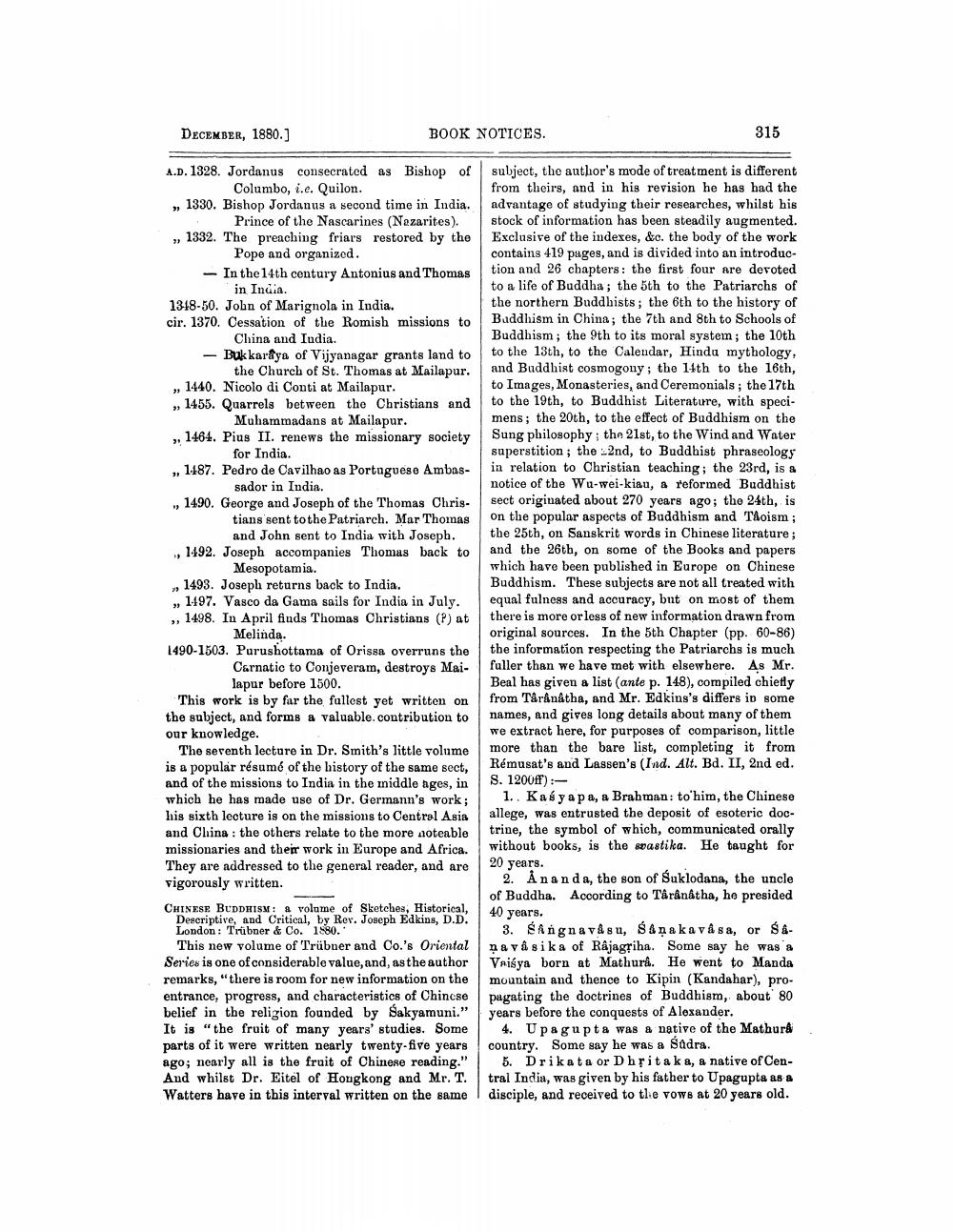________________
DECEMBER, 1880.]
BOOK NOTICES.
315
A.D. 1328. Jordanus consecrated as Bishop of subject, the author's mode of treatment is different Columbo, i.e. Quilon.
from theirs, and in his revision he has had the » 1330. Bishop Jordanus a second time in India. advantage of studying their researches, whilst his
Prince of the Nascarines (Nazarites). stock of information has been steadily augmented. ,,1332. The preaching friars restored by the Exclusive of the indexes, &c. the body of the work Pope and organized.
contains 419 pages, and is divided into an introduc- In the 14th century Antonius and Thomas
tion and 26 chapters: the first four are devoted in India.
to a life of Buddha; the 5th to the Patriarchs of 1318-50. John of Marignola in India.
the northern Buddhists; the 6th to the history of cir. 1370. Cessation of the Romish missions to
Buddhism in China; the 7th and 8th to Schools of China and Iudia.
Buddhism; the 9th to its moral system; the 10th - Buk karaya of Vijyanagar grants land to
to the 13th, to the Calendar, Hindu mythology, the Church of St. Thomas at Mailapur. and Buddhist cosmogony; the 14th to the 16th, „ 1440. Nicolo di Conti at Mailapur.
to Images, Monasteries, and Ceremonials; the 17th ,,1455. Quarrels between the Christians and to the 19th, to Buddhist Literature, with speciMuhammadans at Mailapur.
mens; the 20th, to the effect of Buddhism on the ,,1464. Pius II. renews the missionary society Sung philosophy: the 21st, to the Wind and Water for India.
superstition; the 2nd, to Buddhist phraseologs ,, 1487. Pedro de Cavilhao as Portuguese Ambas- in relation to Christian teaching; the 23rd, is a sador in India.
notice of the Wu-wei-kiau, & reformed Buddhist ., 1490. George and Joseph of the Thomas Chris. sect originated about 270 years ago; the 24th, is
tians sent to the Patriarch. Mar Thomas on the popular aspects of Buddhism and Taoism;
and John sent to India with Joseph. the 25th, on Sanskrit words in Chinese literature; .. 1492. Joseph accompanies Thomas back to and the 26th, on some of the Books and papers Mesopotamia.
which have been published in Europe on Chinese „1493. Joseph returns back to India.
Buddhism. These subjects are not all treated with , 1497. Vasco da Gama sails for India in July. equal fulness and accuracy, but on most of them ,, 1498. In April finds Thomas Christians (R) at there is more or less of new information drawn from Melinda.
original sources. In the 5th Chapter (pp. 60-86) 1490-1503. Purushottama of Orissa overruns the the information respecting the Patriarchs is much Carnatic to Conjeveram, destroys Mai
faller than we have met with elsewhere. As Mr. lapur before 1500.
Beal has given a list (ante p. 148), compiled chiefly This work is by far the fullest yet written on from Tårânátha, and Mr. Edkins's differs in some the subject, and forms a valuable contribution to names, and gives long details about many of them our knowledge.
we extract here, for purposes of comparison, little The seventh lecture in Dr. Smith's little volume more than the bare list, completing it from is a popular résumé of the history of the same sect,
Rémusat's and Lassen's (Ind. Alt. Bd. II, 2nd ed. and of the missions to India in the middle ages, in
S. 1200ff): which he has made use of Dr. Germann's work; 1. Kas y apa, a Brahman: to him, the Chinese his sixth lecture is on the missions to Central Asia allege, was entrusted the deposit of esoteric docand China : the others relate to the more noteable trine, the symbol of which, communicated orally missionaries and their work in Europe and Africa. without books, is the wastika. He taught for They are addressed to the general reader, and are
20 years. vigorously written.
2. Ånanda, the son of Suklodana, the uncle
of Buddha. According to Târânátha, he presided CHINESE BUDDHISM: & volume of Sketches, Historical,
40 years. Descriptive, and Critical, by Rev. Joseph Edkins, D.D. London: Trübner & Co. 1880.
3. Angna và su, s&nak a vå sa, or $ 4This new volume of Trübner and Co.'s Oriental na va sika of Rajagriha. Some say he was a Series is one of considerable value, and, as the author Vaiśya born at Mathura. He went to Manda remarks, "there is room for new information on the mountain and thence to Kipin (Kandahar), proentrance, progress, and characteristics of Chinese pagating the doctrines of Buddhism, about 80 belief in the religion founded by Sakyamuni." years before the conquests of Alexander. It is "the fruit of many years' studies. Some 4. Upagupta was a native of the Mathura parts of it were written nearly twenty-five years country. Some say he was a Sadra. ago; nearly all is the fruit of Chinese reading." 5. Drikata or Dhritaka, a native of CenAnd whilst Dr. Eitel of Hongkong and Mr. T. tral India, was given by his father to Upagupta as & Watters have in this interval written on the same disciple, and received to the vows at 20 years old.




